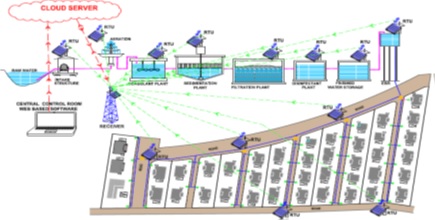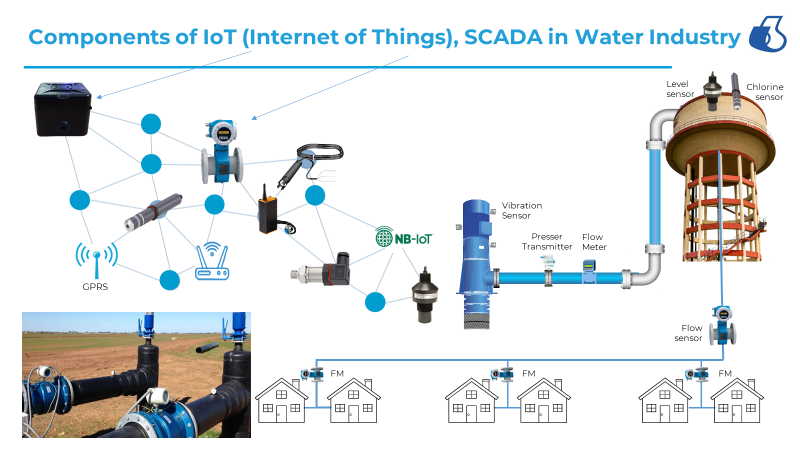By Mohd Zeeshan, Senior Water Professional
As it states, water is essential for life but also the most vulnerable resource, which is often wrongly considered as renewable. Water is not only used in the domestic perspective but also has a vital role in the agriculture and industrial sectors. As the world progresses, water security is becoming the most substantial, social, political, economic and environmental challenge for the humankind. As per a recent study by the Organization for Economic Cooperation and Development (OECD), by the end of 2030, 47 percent of the global population will face water shortage issues. Along with the apparent implication on environment and community, water scarcity will also generate problems for countries’ economic growth, especially to the industries that depend on water for their production process. Initiatives in drought-prone regions underscore the necessity for wastewater reclamation and reuse should be considered an integral and permanent part of resource planning in the future.
Water is a fundamental commodity for all the processes and operations in manufacturing and production industries around the world. Without water, these industries will fail to exist. Virtually water footprint is embedded in every product and accounts for around 40 percent of total water abstraction for industrial usage. Raw water treatment system is used to pre-treat and optimize source water. The pre-treatment aims to improve production efficiency and process performance in particular. The treatment technology for raw water depends on product manufactured and the quality of natural water available in the region. For instance, the deionized water is a prerequisite for medical, electronic, and food processing industries, whereas softened water is required by the boiler feed operations. Generally, suspended and colloidal solids, iron, bacteria, and hardness typically removed during the raw water treatment process. It is often focused on protecting the equipment and pipeline network from scaling, fouling, corrosion, and other forms of damage due to contaminants present in raw water. Industrial water and wastewater is a by-product of industrial and commercial activities—water required for nearly every step of production across the multitude of different industries. According to the United States Geological Survey (USGS), industrial water is used for fabricating, processing, washing, diluting, and cooling of a product. In the industrial water context, the treatment system will largely depend on the compliance regulations for respective industries. For example, the ultrapure water for food & beverage manufacturing will differ to water standard needs for oil and gas plants. Even within the segments of processing, the quality standards vary as mandated. However, in most industries, some treatment steps remain common, like clarification, disinfection, and softening. It is observed that water used by these sectors is consumed wholly and returns as wastewater to the supply system. However, to some extent, it has been degraded by the process it went through when it has been in operation and needs treatment before re-entering into the process cycle. In the recent years water has become the precious resource to be utilized most efficiently. Usage and treatment of water and wastewater is the need of the hour as it is the critical component for most of the industries to sustain. Most of the industries treat their input raw water up to high grade as they deal in highly sophisticated and consumable products.
Deionized water is an essential component for the manufacturing of semiconductors and silicon chips, which is used in all communication devices. This water is used throughout every process, including removing impurities from silicon wafers. Reverse Osmosis and Ion exchange is carried out to remove all the dissolved minerals from the source water before taken into semiconductor processing. It estimated that 100 chips of size 8 inches, requires 2000 gallons of deionized water. Due to this, the semiconductor industry has to maintain high standards of natural water treatment before processing it. Along with this, the sector also considers ways to recycle, reuse, and reduce the amount of water needed for operations. Similarly, the textile industry is the third-largest water-intensive industry globally. A considerable volume of water goes through all the processing operations like dyeing, finishing, bleaching, and mercerizing. Water is the most common and vital solvent for wet processing, and the presence of any impurities would affect the textile wet process. These impurities may cause a defect in the form of shade, variation, unevenness, and damaging the textile material. Before using, textile processing parameters like color, turbidity, alkalinity, hardness, and iron content needs to removed up to prescribed norms. Until not addressed, it will reduce the brightness of the dyes and give a dull shade to the final fabric. The presence of metal ions interferes with the peroxides in bleaching with eventually degrades the fiber quality. So the water should be passed through pre-treatment processes before taking into the process. Furthermore, petroleum is responsible for around 5% of the total withdrawal of water. Water is a raw material used in this industry ranging from the extraction of oil and gases. The activities include injection water, production water, process water, cooling water, tank cleaning water, and others.
The wastewater generated will be highly contaminated with oil and grease, along with sand and dust particles. For protecting the surrounding ecosystem in which this industry operates, wastewater treatment has a significant role to play. The wastewater must pass through the treatment system, capable of removing oil and grease particles and trapping the solid substances. The pulp & paper industry is still considered a waterintensive sector despite digital India’s promotion and switching on e-platform for information sharing. Intrinsically water utilized in all three stages of production, namely pulp making, pulp processing, and paper manufacturing. Besides this, water used in a significant account of its associated activities like cooking, bleaching, and washing. Therefore, this industry consumes a high amount of water, which eventually results in the generation of a large volume of contaminated wastewater as well. Along with these industries, high grade of raw water is required in heavy industries. The boiler is part of a closed system where water is recirculated throughout the course. The water never comes in contact with the atmosphere. The circulated water needs to be treated regularly for efficient operations that to be proficient in producing steam. The boiler feed water treatment system is used to protect boiler unit components and piping from contaminants such as dissolved solids, suspended solids, iron, copper, silica, and dissolved gases present in the boiler system and makeup water. Without proper treatment of the feed water, it should be treated in a way to prevent scaling, corrosion, and priming on the surface of the pipeline or else it can result in costly plant downtime, expensive maintenance charge, and increased fuel consumption with less efficiency. On the same phenomenon, the thermal power plant (TPP) involves the generation of heat from coal or another fuel source to produce steam from demineralized water. The raw water should be free from suspended solids and metallic ions. The ions, if present, will react with the surface of steam generating pipeline and decreases the efficiency of steam production and demands high input fuel cost. The pre-treatment of the raw water depends on the source type from where water extracted. But removing TSS, organic material, and metallic ions remains the same for all water sources. With the treated water intake for steam generation, increases the steam quality and efficiency of the TPP in general.
Afterwards it is concluded that the industrialization has gradually increased the concern related to the contamination of the water resources—the unplanned side effects which arise from releasing chemicals into our immediate surroundings. The substances from significant industries like metal ions, oil-grease, and colored water from industries like ore, petrochemical, and textiles respectively share a substantial part in polluting water when released untreated. The successful treatment of raw water and wastewater from water-intensive industries requires careful planning, economic and financial analysis, and environmental impact assessment should take into consideration. Technologies for treating water and wastewater must depend on the accurate cost analysis up to the point where it is technically feasible to manufacture. A combination of precipitation, ion-exchange, reverse osmosis, adsorption by activated carbon medium are some of the techniques that have been used for removing metal ions from industrial wastewater. These options are expensive, but an economic analysis may establish that it will be balanced in the future with increased operating costs. Through the integrated water reuse planning, the reclaimed water will provide flexibility to satisfy short term needs as well as reliability in water supply by minimizing dependence on the natural water resources. The effective integration of reclaimed wastewater will primarily reduce the use of freshwater, based on the mandated quality required for a specific application and the associated water quality requirements.





